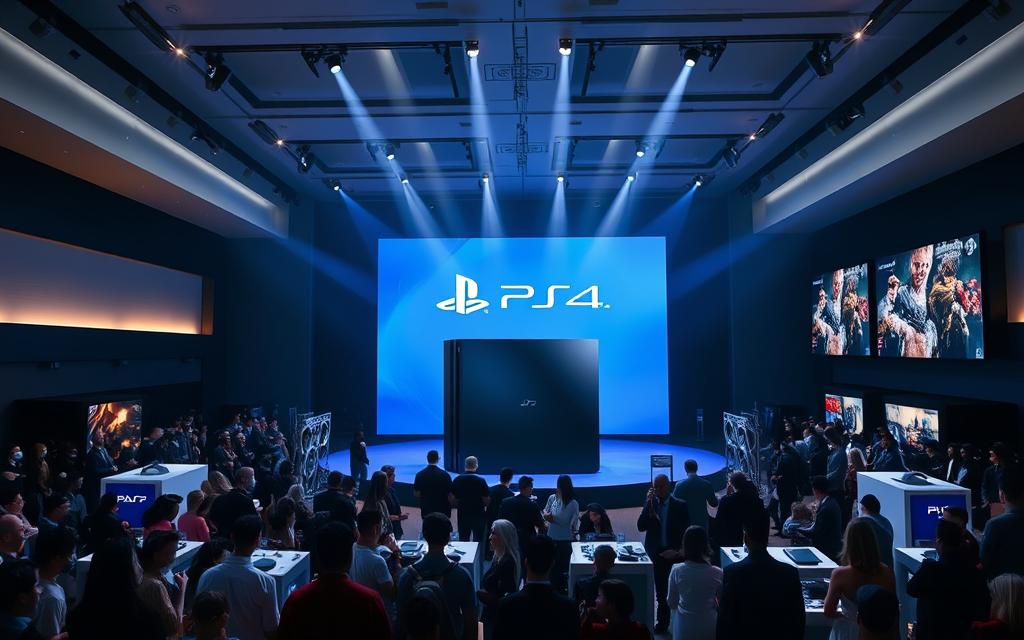Step-by-Step Guide: When did the ps4 come out
Sony’s PlayStation 4 console was a significant release in the gaming industry, marking a major milestone in the eighth console generation.
The launch date was announced in August 2013, with the console being released on November 15, 2013, in North America and November 29, 2013, in Europe, including the UK.
Priced at $399 in the US and £349 in the UK, the PS4 was £80 cheaper than Microsoft’s Xbox One, making it a competitive option in the market.
The PS4 represented Sony’s fourth major home console release, arriving approximately seven years after the PlayStation 3 debuted in 2006.
This comprehensive guide will explore the PS4’s release, from initial development through global launch dates and beyond, examining its technical specifications, games, and pricing strategies.
The Birth of PlayStation 4: Sony’s Next-Generation Console
Sony’s vision for the PS4 was centered around creating a true next-generation gaming console that would surpass its predecessors. The company aimed to address the limitations of the PS3 while pushing technological boundaries.
Sony’s Vision for the PS4
The PS4 was designed as a next-generation computer entertainment system that aimed to redefine rich and immersive gaming experiences with powerful graphics and speed. It also included deeply integrated social capabilities and innovative second-screen features utilizing devices such as PlayStation Vita.
Sony positioned the PS4 as a console that was gaming-first, deliberately contrasting with Microsoft’s initial entertainment-focused approach for the Xbox One. The company made strategic decisions to use more standardized PC-like architecture with x86-64 AMD “Jaguar” CPU, making game development more straightforward compared to the complex Cell processor in the PS3.
Development Timeline
The development of the PS4 began shortly after the PS3’s launch, with Sony taking developer feedback seriously to create a more accessible system architecture. The company consulted extensively with game developers to ensure the platform would meet their needs and facilitate easier game creation.
The PlayStation brand had established itself as a major force in the gaming industry through previous generations, and the PS4 was designed to strengthen this position. Sony’s internal development studios were heavily involved in creating showcase titles that would demonstrate the new console‘s capabilities at launch.
| Feature | Description | Benefit |
|---|---|---|
| x86-64 AMD “Jaguar” CPU | Standardized PC-like architecture | Easier game development |
| Integrated Social Capabilities | Deep social integration | Enhanced gaming experience |
| Second-Screen Features | Innovative features with PlayStation Vita | Increased player engagement |
When Did the PS4 Come Out: Official Release Dates
Sony Computer Entertainment Inc. announced the official release dates for the PS4, marking a significant milestone in the gaming industry. The launch date was strategically planned to capture the holiday shopping season and gain a competitive edge.
North American Launch – November 15, 2013
The PlayStation 4 officially launched on November 15, 2013, in North America, signaling Sony’s entry into the eighth generation of video game consoles. This timely release allowed Sony to capitalize on the crucial holiday shopping season, giving them a head start in the region.
European and UK Launch – November 29, 2013
Two weeks after the North American launch, Sony implemented a staggered global release strategy, with the European and UK markets receiving the console on November 29, 2013. This launch date included 20 countries, demonstrating Sony’s robust distribution capabilities and global market approach.
Global Rollout Strategy
Sony’s global rollout strategy prioritized major gaming markets first, with Asian territories outside Japan following in December 2013. Interestingly, Japan didn’t receive the PS4 until February 22, 2014, marking one of the few times Sony’s home market wasn’t prioritized for a PlayStation launch. The strategic timing of the PS4 release gave Sony approximately a one-week advantage over Microsoft’s Xbox One, which launched on November 22, 2013, in major markets.
PS4 Launch Price and Market Positioning
Sony positioned the PS4 at an attractive price to capture a larger market share. The console’s launch price was a critical factor in its initial success and market reception.
Regional Pricing Breakdown
The PS4 was launched at $399 in the US and £349 in the UK. This pricing strategy showed consistent positioning across different markets, with adjustments made for local currencies and taxes.
- The console was priced competitively, making it an attractive option for gamers.
- The regional pricing breakdown reflected Sony’s understanding of different market conditions.
- The launch price was more accessible than the PS3’s initial pricing tiers.
Comparison with Xbox One Pricing
The PS4’s price was £80 cheaper than the Xbox One in the UK, retailing at £429. This difference gave Sony a significant advantage in the console war.
- Sony’s decision to undercut Microsoft’s Xbox One by $100/£80 was a deliberate strategy.
- The comparison with Xbox One pricing became a major talking point during marketing campaigns.
- Market analysts recognized the pricing advantage, adjusting odds to favor PS4 outselling Xbox One.
The additional costs for consumers, such as extra DualShock4 controllers and the PlayStation Camera, were priced competitively against Xbox accessories, complementing the overall value proposition of the PS4 console and its ecosystem.
Technical Specifications and Hardware Features
The PlayStation 4’s technical specifications marked a significant upgrade from its predecessor, featuring a custom AMD APU that combined an 8-core x86-64 “Jaguar” CPU with a 1.84 TFLOPS Radeon-based GPU. This powerful processing power enabled the console to deliver high-performance gaming. The PS4’s hardware was designed to provide a superior gaming experience.
Processing Power and Memory
The PS4 featured a single-chip custom processor with an x86-64 AMD “Jaguar” 8-core CPU and a 1.84 TFLOPS AMD next-generation Radeon-based GPU. It included 8GB of GDDR5 memory, providing developers with substantial bandwidth for game development. According to the technical specifications on Wikipedia, this configuration represented a significant leap in processing capability.
Storage and Connectivity Options
The system included a user-replaceable 500GB hard drive, allowing for future expansion as digital libraries grew. The console featured comprehensive connectivity options, including Super-Speed USB (USB3.0) ports, an AUX port, Ethernet, IEEE 802.11 b/g/n Wi-Fi, and Bluetooth 2.1. This range of options enabled users to connect their PS4 to various devices and networks.
DualShock4 Controller Innovations
The DualShock4 controller introduced several innovations, including an integrated touchpad, motion sensing capabilities, a light bar for player identification, and a dedicated “Share” button for social features. These features enhanced the gaming experience and provided new ways for players to interact with games and share their experiences.
The PS4’s power consumption was rated at a maximum of 250W, representing improved efficiency compared to previous generation hardware. The console’s design and hardware architecture choices prioritized developer accessibility and gaming performance, using familiar x86 architecture that simplified cross-platform development.
Launch Titles and Software Lineup
The initial launch of the PS4 was accompanied by a compelling array of games that demonstrated its advanced features. The console’s launch lineup was diverse, with a mix of first-party exclusives, third-party titles, and digital download options.
First-Party Exclusives
Sony’s first-party exclusives played a crucial role in showcasing the PS4’s capabilities. Titles like Killzone: Shadow Fall and Knack were highly anticipated and demonstrated the console’s graphical prowess. DriveClub, although delayed, was another significant exclusive that highlighted the PS4’s features.
Third-Party Support
The PS4 enjoyed robust support from third-party developers, with major publishers like Activision, Electronic Arts, and Ubisoft releasing cross-generation versions of their popular franchises. Games such as Call of Duty: Ghosts, Battlefield 4, and FIFA 14 were among the notable third-party titles available at launch.
| Game Title | Developer | Genre |
|---|---|---|
| Killzone: Shadow Fall | Guerrilla Games | First-Person Shooter |
| Call of Duty: Ghosts | Infinity Ward | First-Person Shooter |
| FIFA 14 | EA Canada | Sports |
Digital Download Options
The PS4 also offered a range of digital download options at launch, highlighting Sony’s focus on digital distribution. The PlayStation Store featured full games, indie titles, and downloadable content, providing gamers with a variety of choices. With over 180 PS4 games in development at the time of launch, the console had a strong foundation for its future growth.
In total, the PS4 launched with 15 physical Blu-ray titles and 18 digital download games, totaling 33 titles available during the launch window. This diverse lineup catered to different tastes and preferences, setting the stage for the console’s success.
PS4’s Revolutionary Features and Services
Upon its release, the PS4 redefined the gaming experience with its cutting-edge features and services, setting a new standard for the industry.
PlayStation Network Enhancements
The PS4 introduced significant enhancements to the PlayStation Network (PSN), improving online infrastructure, store functionality, and account management systems. These upgrades made it easier for players to access and manage their gaming content. The PSN’s improved capabilities supported a more seamless gaming experience, allowing for smoother online interactions and community engagement.
Social Integration and Sharing Capabilities
The PS4’s innovative social features were a major highlight, with the dedicated “Share” button on the DualShock4 controller enabling instant gameplay broadcasting and screenshot sharing on platforms like Twitch. This integration represented a forward-thinking approach to gaming’s growing spectator culture, allowing players to share their experiences with minimal setup. The console’s social capabilities extended beyond sharing to include expanded friends lists and activity feeds.
PlayStation Plus Benefits
PlayStation Plus (PS Plus) evolved into an essential component of the PS4 experience, becoming a requirement for online multiplayer while offering players monthly games and exclusive discounts. The service provided significant value to subscribers, enhancing their overall gaming experience on the platform. Regular updates to the PS4’s system software further enriched the user experience, adding new features and improving functionality throughout the console’s lifecycle.
| Feature | Description | Benefit |
|---|---|---|
| Enhanced PSN | Improved online infrastructure and store functionality | Smoother gaming experience |
| Social Integration | Instant gameplay broadcasting and screenshot sharing | Enhanced community engagement |
| PlayStation Plus | Monthly games and exclusive discounts | Increased value for subscribers |
Market Reception and Initial Sales Performance
The PS4’s initial sales performance set the tone for its dominance in the market. The console’s launch was highly anticipated, and Sony’s strategy paid off with remarkable pre-order numbers and launch day sales.
Pre-Order Numbers and Launch Day Sales
The PlayStation 4 enjoyed extraordinary pre-launch demand, with Sony announcing over one million pre-orders globally before the console’s release date. On launch day, the PS4 sold over one million units within the first 24 hours in North America alone, setting a new record for console launches. Many retailers reported selling out of their initial PS4 allocations, leading to widespread stock shortages that persisted through the 2013 holiday season.
| Region | Launch Date | First Day Sales |
|---|---|---|
| North America | November 15, 2013 | Over 1 million units |
| Europe | November 29, 2013 | Strong sales, exact figures not disclosed |
Critical Reception from Gaming Media
Critical reception from gaming media was overwhelmingly positive, with reviewers praising the console’s powerful hardware, developer-friendly architecture, and competitive pricing. The gaming press particularly highlighted the PS4’s focus on core gaming experiences as a strength, contrasting it with Microsoft’s initially broader entertainment approach for Xbox One.
Market analysts attributed the PS4’s strong reception to a combination of factors, including pricing strategy, clear messaging about game sharing and online requirements, and strong relationships with third-party developers. The console’s momentum continued into 2014, with Sony reporting 5.3 million units sold by February 2014 and 7 million by April 2014, establishing an early lead in the console generation.
PS4 Evolution: From Original Model to Slim and Pro Versions
The PS4’s evolution was marked by the introduction of Slim and Pro versions, showcasing Sony’s commitment to innovation and customer satisfaction.
PS4 Slim – September 2016
The PS4 Slim, released on September 15, 2016, was a significant redesign of the original console. It featured a 40% smaller physical footprint and improved energy efficiency. The Slim model was available in two storage sizes: 500 GB and 1 TB, priced at $299 and $349, respectively.
The new design was not just about aesthetics; it also included updates to USB and Bluetooth capabilities, making it a more refined version of the original PS4.
PS4 Pro – November 2016
Just a couple of months later, on November 10, 2016, Sony released the PS4 Pro, a more powerful version of the console. The PS4 Pro was designed to support 4K output and enhance the gaming experience with improved hardware.
| Model | Release Date | Storage | Price |
|---|---|---|---|
| PS4 Slim | September 15, 2016 | 500 GB / 1 TB | $299 / $349 |
| PS4 Pro | November 10, 2016 | 1 TB | $399 |
Both the Slim and Pro models maintained compatibility with the existing PS4 game library, ensuring that users could continue to enjoy their favorite games without interruption.
Conclusion: The PS4’s Legacy and Impact on Gaming
With its release, the PS4 revolutionized the gaming industry in ways that still resonate today. As Sony’s fourth major home console, it arrived approximately seven years after the PlayStation 3 debuted in 2006, and instantly dominated the generation ahead of the Xbox One.
The PS4’s legacy is multifaceted. It has secured its place in gaming history as one of the most successful consoles of all time, with lifetime sales exceeding 117 million units as of 2022. The system established a developer-friendly environment, attracting both major publishers and independent creators, resulting in a diverse game library.
Over its lifespan, the PS4 hosted numerous generation-defining exclusive titles, cementing Sony’s reputation for high-quality first-party content. The console’s long-term success validated Sony’s gaming-first approach and influenced the company’s strategy for the subsequent PlayStation 5. Even years after the PS5’s launch, the PS4 continues to receive cross-generation support, with many major titles still releasing on the platform.
The PlayStation 4 will be remembered as the console that helped mainstream gaming reach new heights of cultural relevance, with its accessibility, social features, and diverse games appealing to the broadest audience in PlayStation history, making it a significant part of the company’s brand identity over the past year.
FAQ
What were the release dates for the PS4 in different regions?
The PS4 was launched in North America on November 15, 2013, and in Europe and the UK on November 29, 2013. Sony implemented a strategic global rollout to ensure a successful launch across various markets.
What was the launch price of the PS4, and how did it compare to the Xbox One?
The PS4 launched at a price of 9 in the US, which was 0 less than the Xbox One. This competitive pricing helped Sony gain a market advantage.
What were the key technical specifications of the PS4?
The PS4 featured an x86-64 AMD Jaguar 8-core CPU, 8 GB of GDDR5 RAM, and a powerful Radeon GPU. These specs enabled smooth gaming performance and supported advanced graphics capabilities.
What innovative features were introduced with the DualShock 4 controller?
The DualShock 4 controller introduced a share button for easy game clip sharing, a touchpad for new gameplay mechanics, and a light bar for player identification. These features enhanced the overall gaming experience.
What were some of the notable launch titles for the PS4?
The PS4 launched with popular titles like Knack, Assassin’s Creed IV: Black Flag, and Call of Duty: Ghosts. These games showcased the console’s capabilities and attracted a diverse player base.
How did the PS4 support digital downloads and online gaming?
The PS4 featured a robust PlayStation Network (PSN) for digital downloads, online multiplayer, and community features. The console also supported PlayStation Plus benefits, including free games and exclusive discounts.
What updates and improvements were made to the PS4 over time?
Sony released several updates, including the PS4 Slim and PS4 Pro models, which offered improved performance, new features, and enhanced hardware. These updates helped keep the console competitive in the market.
How did the gaming community receive the PS4 at launch?
The PS4 received positive reviews from critics and gamers alike, with praise for its hardware, controller, and exclusive titles. The console’s strong launch sales and positive reception helped establish it as a major player in the gaming market.












